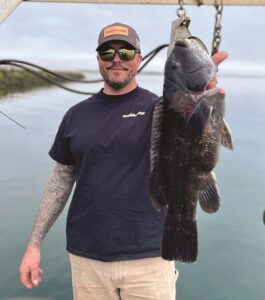The northern fringe of the striped bass migration reached Rhode Island this past week, and if we continue to get this unseasonably warm weather the bass could be in our vicinity by early May.
Speaking of which, fisheries biologists with the state of Massachusetts have been working to understand what factors affect the survival of striped bass that have been caught and released by recreational fishermen. Using specialized transmitter tags that sensed the tailbeats of 350 such fish caught by single baited hooks, they were able to determine which ones died and investigate why.
The two-year study concluded that bass survival is related to three factors: hook location, water temperature, and handling time. The results are interesting, if predictable. Fish caught in 60° to 70° F water, hooked in the gills, and handled out of the water for two minutes had an alarming 85-percent mortality rate. Fish hooked in the stomach in the same temperature range and handled similarly did a little better, with a 50-percent mortality rate. Fish hooked in the esophagus had better outcomes, with a 30-percent mortality rate. Fish hooked in the mouth had the lowest mortality rate of 5 percent.

What does this all mean to the recreational angler? For one, it supports the current policy of using circle hooks only and not J hooks. Circle hooks have proved to result in far more mouth hookings than stomach or gill hookings.
It also reinforces the fact that when we throw back a bass that we can’t keep because we are either already limited out or the fish is not a keeper, and that fish has been hooked in the gills or stomach, it will more than likely die.
In these cases, we are essentially feeding the crabs and not doing anything to help conservation. This is one of the ironic unintended consequences of the current policy.
I still firmly believe that to protect the species the policy should be the first fish you catch, regardless of its size, should be the one you can keep, period. Every year, I see a large number of “floaters” — fish that were thrown back because they weren’t keepers, got handled improperly, were stomach- or gill-hooked, and died soon after being tossed back into the water. All in the name of conservation.
Anyone who spends a lot of time on the water during a good bass bite can see that the laws as they are written are not working.
The tautogs are beginning to bite, and some good-size fish have been taken along the edges of the breakwater in Provincetown. Green crabs, fiddler crabs, and pieces of clam all work well, but you have to put your bait in and around structures — rocks, sunken docks, pier pilings, or wrecks — because these fish do not wander far from these. Tautogs fight hard and they are good eating fish.
The North Atlantic right whales are still here between Wood End Light and Race Point, actively skim-feeding on all the rich plankton currently in our waters. The whales are visible from the beach at Herring Cove, but the Dolphin Fleet began making whale-watching trips last week, too, so that’s another option. Now is the time to get out and see the whales because they will be gone soon, continuing their northerly migration.



